Handling Complex Missing Data Using Random Forest Approach for an Air Quality Monitoring Dataset: A Case Study of Kuwait Environmental Data (2012 to 2018)
Abstract
1. Introduction
1.1. Missing Completely at Random (MCAR)
1.2. Missing at Random (MAR)
1.3. Missing Not at Random (MNAR)
1.4. Ignoring the Missing Data Mechanism
- MAR: when the missing data pattern is missing at random; and
- Distinctness: when the joint parameter space of is equal to the product of the parameter space of and [12].
1.5. Multiple Imputation (MI)
2. Materials and Methods
2.1. Multiple Imputation Using Random Forest Method
- : the observed values of .
- : the missing values of .
- : the observations, that belong in the other variables .
- : the observations, , that belong in the other variables .
2.2. Process of Multiple Imputations (MI) Using Rubin’s Rules
2.3. Data Sets
- Air quality data: The air pollutant variables in the air quality data were , , , , and ;
- Meteorological data: The meteorological parameters included temperature, humidity, wind direction, and wind speed.
2.4. Evaluation Criteria
2.5. R Packages Used for Imputation Process
3. Statistical Results
Missing Data Patterns
4. Discussion
5. Conclusions
Author Contributions
Funding
Institutional Review Board Statement
Informed Consent Statement
Data Availability Statement
Acknowledgments
Conflicts of Interest
Appendix A. Figures
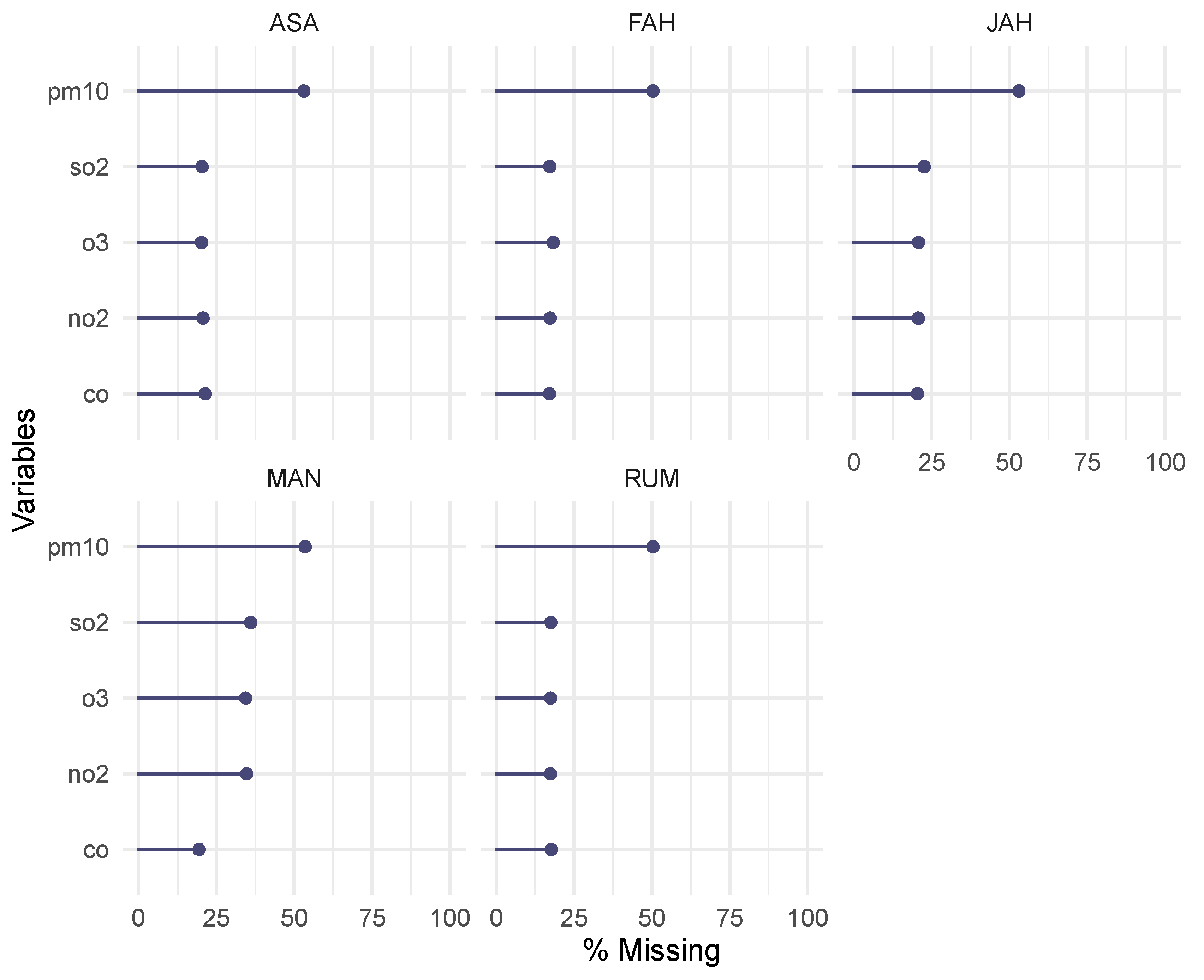
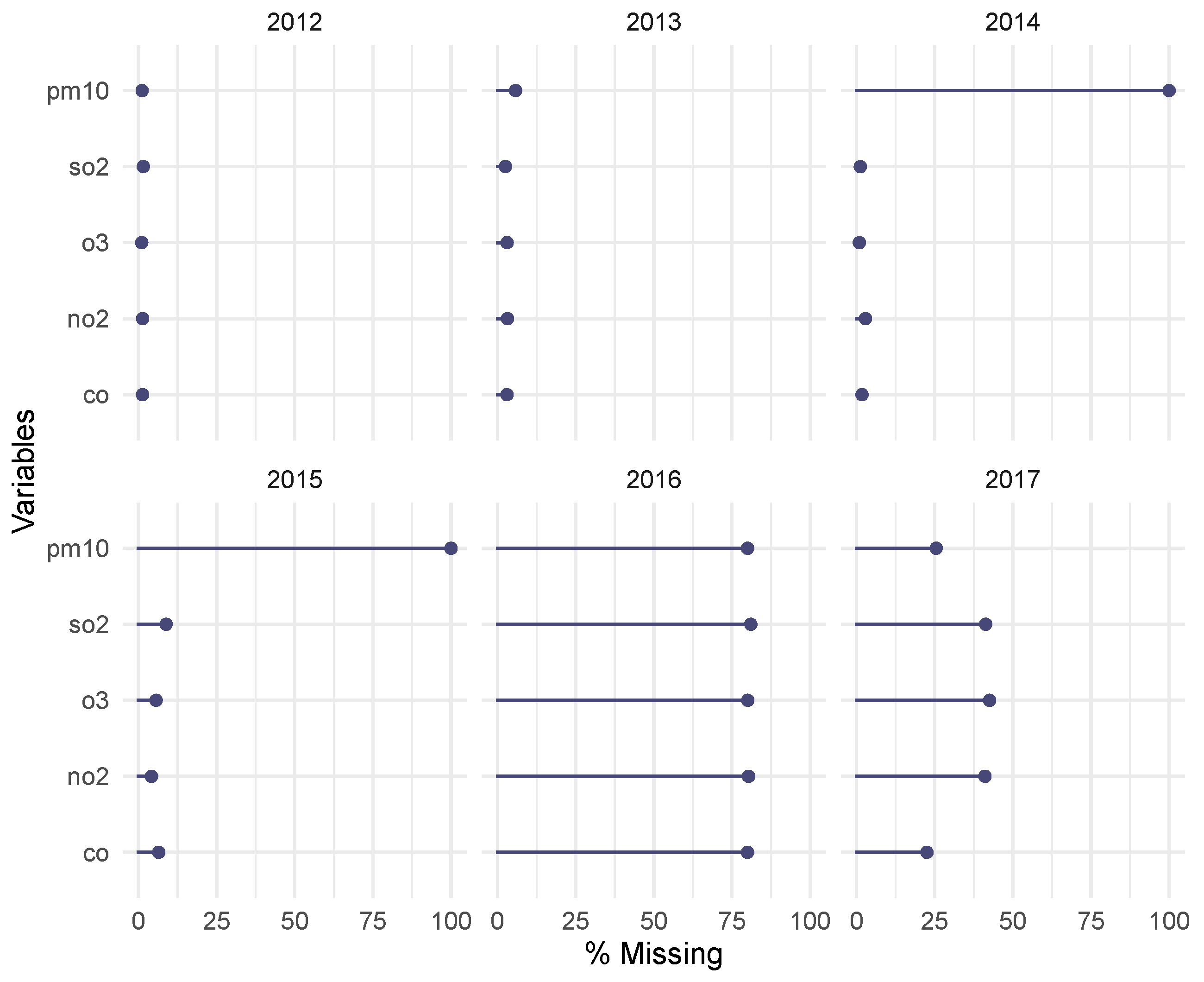

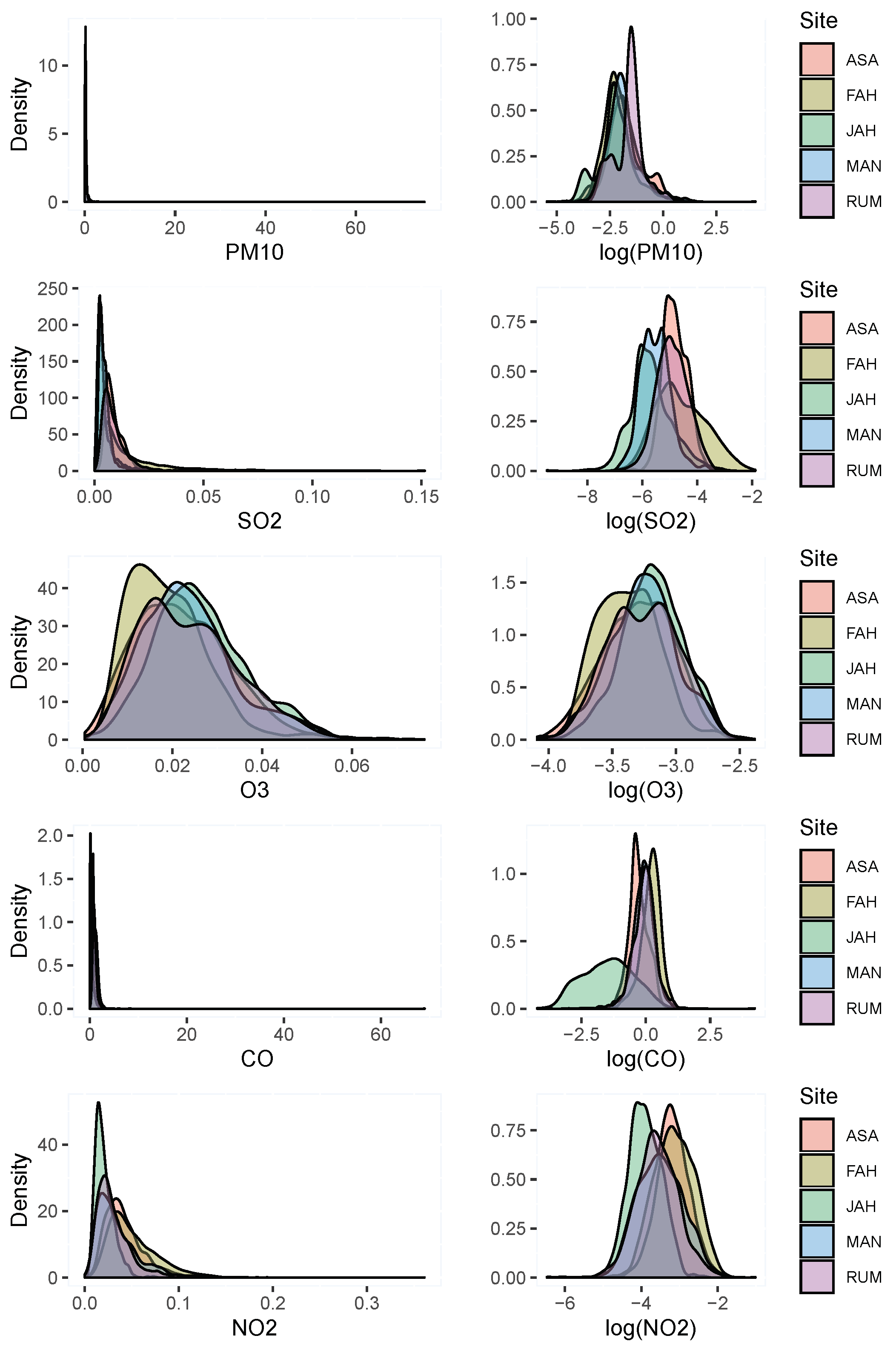
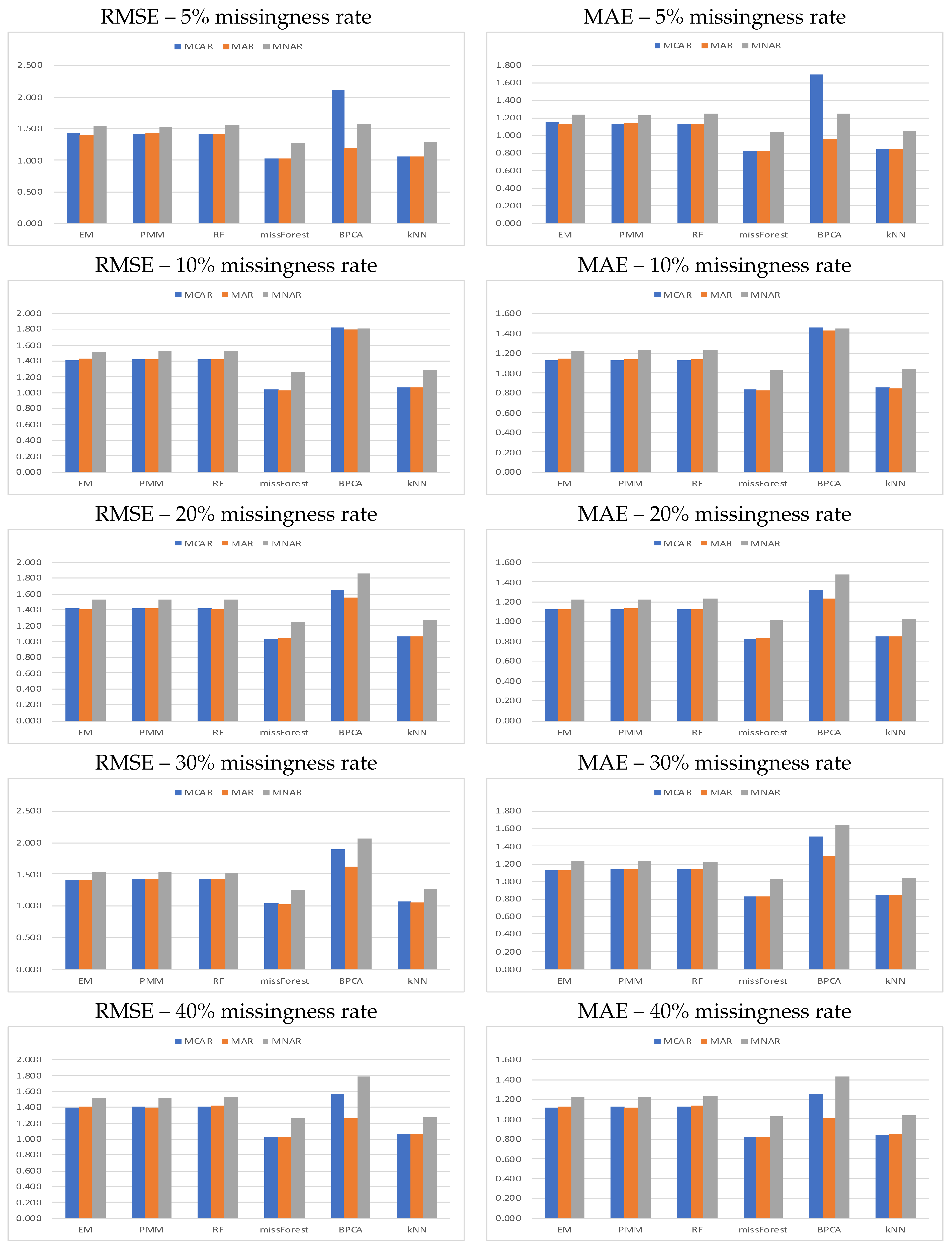
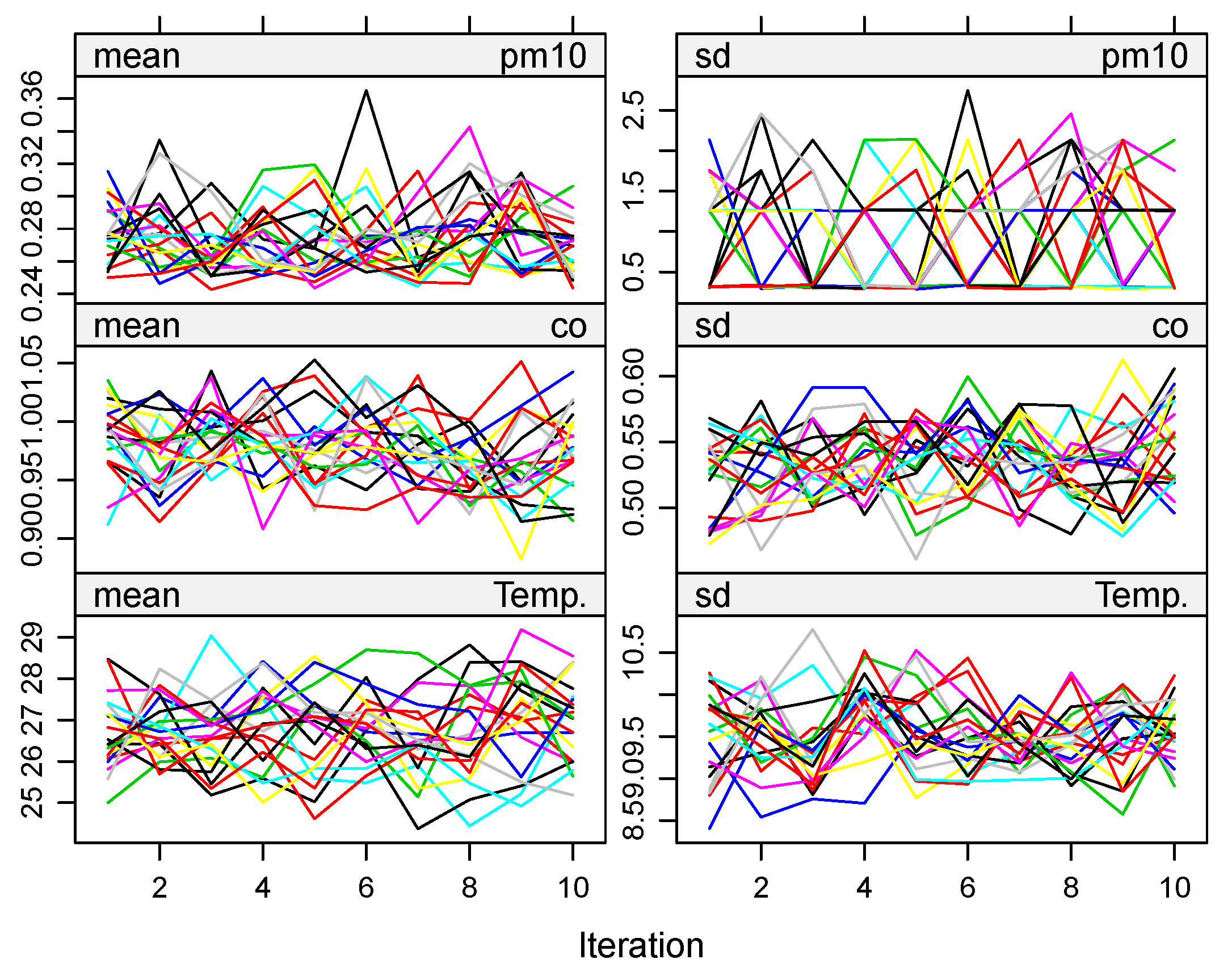
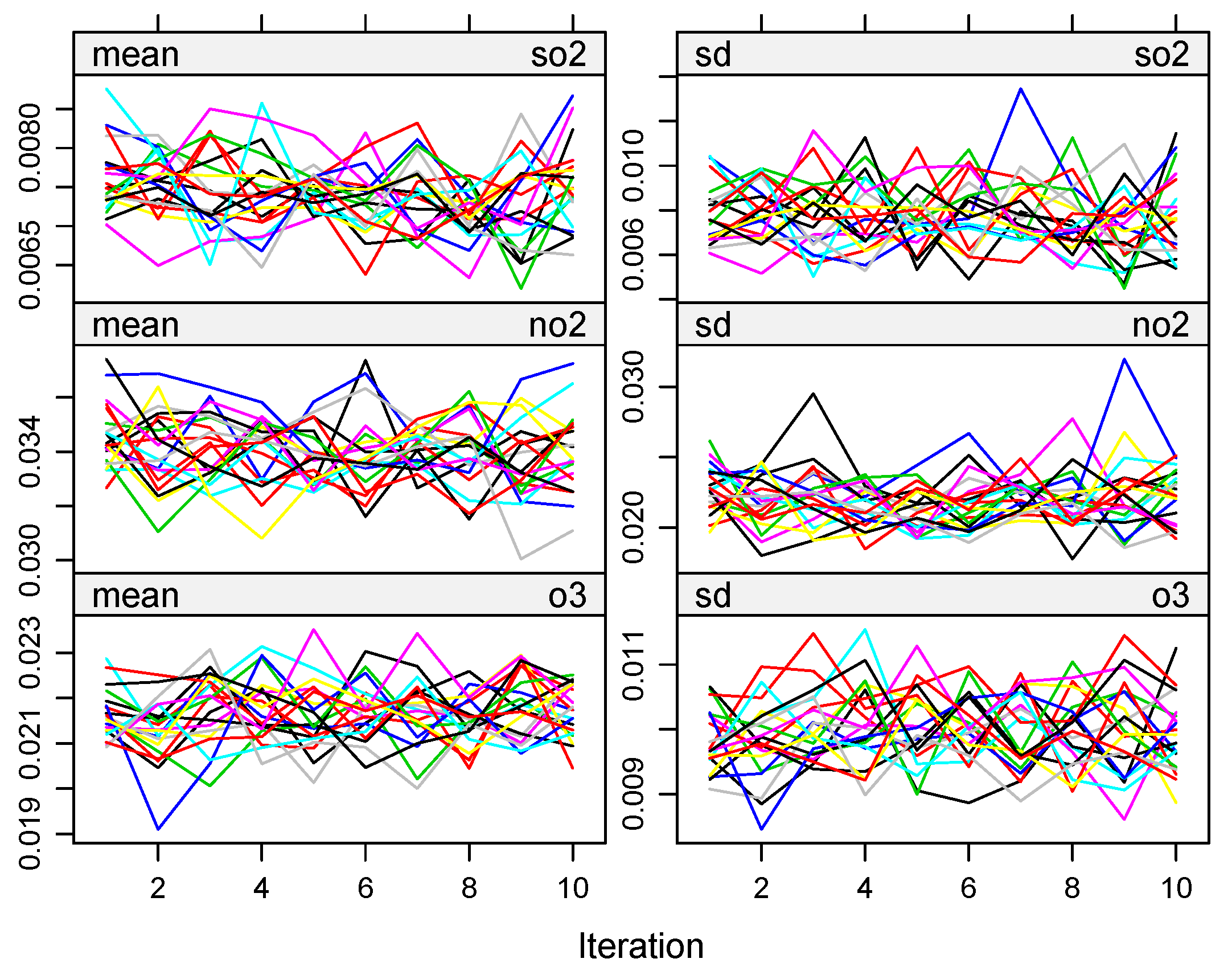

Appendix B. Algorithms-MissForest
| Algorithm A1: Impute missing values with random forest [28]. |
|
Require: X is an n × p matrix, setup stopping criterion () setup initial guess for missing values; vector of sorted indices of columns in w.r.t. increasing amount of missing values; while not do store previously imputed matrix; for s in do Fit a random forest: ; Predict using ; update imputed matrix, using predicted ; end for update end while return the imputed matrix |
References
- Norazian, M.N.; Shukri, Y.A.; Azam, R.N.; Al Bakri, A.M.M. Estimation of missing values in air pollution data using single imputation techniques. Sci. Asia 2008, 34, 341–345. [Google Scholar] [CrossRef]
- Norris, G.; Duvall, R.; Brown, S.; Bai, S. Epa Positive Matrix Factorization (pmf) 5.0 Fundamentals and User Guide Prepared for the Us Environmental Protection Agency Office of Research and Development; Petaluma Inc.: Washington, DC, USA, 2014. [Google Scholar]
- Junger, W.; de Leon, A.P. Missing data imputation in time series of air pollution. Epidemiology 2009, 20, S87. [Google Scholar] [CrossRef]
- Forbes, D.; Hawthorne, G.; Elliott, P.; McHugh, T.; Biddle, D.; Creamer, M.; Novaco, R.W. A concise measure of anger in combat-related posttraumatic stress disorder. J. Trauma. Stress Off. Publ. Int. Soc. Trauma. Stress Stud. 2004, 17, 249–256. [Google Scholar] [CrossRef] [PubMed]
- Jadhav, A.; Pramod, D.; Ramanathan, K. Comparison of Performance of Data Imputation Methods for Numeric Dataset. Appl. Artif. Intell. 2019, 33, 913–933. [Google Scholar] [CrossRef]
- Hawthorne, G.; Hawthorne, G.; Elliott, P. Imputing cross-sectional missing data: Comparison of common techniques. Aust. N. Z. J. Psychiatry 2005, 39, 583–590. [Google Scholar] [CrossRef]
- Plaia, A.; Bondi, A. Single imputation method of missing values in environmental pollution data sets. Atmos. Environ. 2006, 40, 7316–7330. [Google Scholar] [CrossRef]
- Farhangfar, A.; Kurgan, L.; Dy, J. Impact of imputation of missing values on classification error for discrete data. Pattern Recognit. 2008, 41, 3692–3705. [Google Scholar] [CrossRef]
- Graham, J.W. Missing data analysis: Making it work in the real world. Annu. Rev. Psychol. 2009, 60, 549–576. [Google Scholar] [CrossRef]
- Rubin, D.B. Multiple imputation after 18+ years. J. Am. Stat. Assoc. 1996, 91, 473–489. [Google Scholar] [CrossRef]
- Little, R.J.; Rubin, D.B. Statistical Analysis with Missing Data; John Wiley & Sons, Inc.: Hoboken, NJ, USA, 2019; Volume 793. [Google Scholar]
- Schafer, J.L.; Olsen, M.K. Multiple imputation for multivariate missing-data problems: A data analyst’s perspective. Multivar. Behav. Res. 1998, 33, 545–571. [Google Scholar] [CrossRef]
- Haji-Maghsoudi, S.; Haghdoost, A.A.; Rastegari, A.; Baneshi, M.R. Influence of pattern of missing data on performance of imputation methods: An example using national data on drug injection in prisons. Int. J. Health Policy Manag. 2013, 1, 69. [Google Scholar] [CrossRef] [PubMed][Green Version]
- Lee, K.J.; Carlin, J.B. Recovery of information from multiple imputation: A simulation study. Emerg. Themes Epidemiol. 2012, 9, 3. [Google Scholar] [CrossRef] [PubMed]
- Marshall, A.; Altman, D.G.; Holder, R.L. Comparison of imputation methods for handling missing covariate data when fitting a Cox proportional hazards model: A resampling study. BMC Med. Res. Methodol. 2010, 10, 112. [Google Scholar] [CrossRef] [PubMed]
- Heitjan, D.F.; Rubin, D.B. Inference from coarse data via multiple imputation with application to age heaping. J. Am. Stat. Assoc. 1990, 85, 304–314. [Google Scholar] [CrossRef]
- King, G.; Honaker, J.; Joseph, A.; Scheve, K. Analyzing incomplete political science data: An alternative algorithm for multiple imputation. Am. Political Sci. Rev. 2001, 95, 49–69. [Google Scholar] [CrossRef]
- Newman, D.A. Missing data: Five practical guidelines. Organ. Res. Methods 2014, 17, 372–411. [Google Scholar] [CrossRef]
- Allison, P.D. Multiple imputation for missing data: A cautionary tale. Sociol. Methods Res. 2000, 28, 301–309. [Google Scholar] [CrossRef]
- White, I.R.; Daniel, R.; Royston, P. Avoiding bias due to perfect prediction in multiple imputation of incomplete categorical variables. Comput. Stat. Data Anal. 2010, 54, 2267–2275. [Google Scholar] [CrossRef]
- Allen, R.J.; DeGaetano, A.T. Estimating missing daily temperature extremes using an optimized regression approach. Int. J. Climatol. J. R. Meteorol. Soc. 2001, 21, 1305–1319. [Google Scholar] [CrossRef]
- Kotsiantis, S.; Kostoulas, A.; Lykoudis, S.; Argiriou, A.; Menagias, K. Filling missing temperature values in weather data banks. In Proceedings of the 2006 2nd IET International Conference on Intelligent Environments, Athens, Greece, 5–6 July 2006; Volume 1, pp. 327–334. [Google Scholar]
- Jagannathan, G.; Wright, R.N. Privacy-preserving imputation of missing data. Data Knowl. Eng. 2008, 65, 40–56. [Google Scholar] [CrossRef]
- Lakshminarayan, K.; Harp, S.A.; Samad, T. Imputation of missing data in industrial databases. Appl. Intell. 1999, 11, 259–275. [Google Scholar] [CrossRef]
- Van Ginkel, J.R.; Van der Ark, L.A.; Sijtsma, K.; Vermunt, J.K. Two-way imputation: A Bayesian method for estimating missing scores in tests and questionnaires, and an accurate approximation. Comput. Stat. Data Anal. 2007, 51, 4013–4027. [Google Scholar] [CrossRef]
- Schenker, N.; Taylor, J.M. Partially parametric techniques for multiple imputation. Comput. Stat. Data Anal. 1996, 22, 425–446. [Google Scholar] [CrossRef]
- Breiman, L. Random forests. Mach. Learn. 2001, 45, 5–32. [Google Scholar]
- Stekhoven, D.J.; Bühlmann, P. MissForest—Non-parametric missing value imputation for mixed-type data. Bioinformatics 2012, 28, 112–118. [Google Scholar] [CrossRef]
- Oba, S.; Sato, M.a.; Takemasa, I.; Monden, M.; Matsubara, K.I.; Ishii, S. A Bayesian missing value estimation method for gene expression profile data. Bioinformatics 2003, 19, 2088–2096. [Google Scholar] [CrossRef]
- Norazian, M.N.; Shukri, A.; Yahaya, P.; Azam, N.; Ramli, P.; Fitri, N.F.; Yusof, M.; Mohd Mustafa Al Bakri, A. Roles of imputation methods for filling the missing values: A review. Adv. Environ. Biol. 2013, 7, 3861–3869. [Google Scholar]
- Alsaber, A.; Pan, J.; Al-Herz, A.; Alkandary, D.S.; Al-Hurban, A.; Setiya, P.; KRRD Group. Influence of ambient air pollution on rheumatoid arthritis disease activity score Index. Int. J. Environ. Res. Public Health 2020, 17, 416. [Google Scholar] [CrossRef]
- Al-Shayji, K.; Lababidi, H.; Al-Rushoud, D.; Al-Adwani, H. Development of a fuzzy air quality performance indicator. Kuwait J. Sci. Eng. 2008, 35, 101–126. [Google Scholar]
- Johnson, M.; Isakov, V.; Touma, J.; Mukerjee, S.; Özkaynak, H. Evaluation of land-use regression models used to predict air quality concentrations in an urban area. Atmos. Environ. 2010, 44, 3660–3668. [Google Scholar] [CrossRef]
- Fitz-Simons, T. Guideline for Reporting of Daily Air Quality: Air Quality Index (AQI); Technical Report; Environmental Protection Agency, Office of Air Quality Planning and Standards: Research Triangle Park, NC, USA, 1999.
- Bennett, N.; Croke, B.; Guariso, G.; Guillaume, J.A.; Hamilton, S.H.; Jakeman, A.J.; Marsili-Libelli, S.; Newham, L.T.H.; Norton, J.P.; Perrin, C.; et al. Characterising performance of environmental models. Environ. Modell. Softw. 2013, 40, 1–20. [Google Scholar] [CrossRef]
- Kowarik, A.; Templ, M. Imputation with the R Package VIM. J. Stat. Softw. 2016, 74, 1–16. [Google Scholar] [CrossRef]
- Royston, P. Multiple imputation of missing values. Stata J. 2004, 4, 227–241. [Google Scholar] [CrossRef]
- Buuren, S.V.; Groothuis-Oudshoorn, K. mice: Multivariate imputation by chained equations in R. J. Stat. Softw. 2010, 85, 1–68. [Google Scholar] [CrossRef]
- Horton, N.J.; Lipsitz, S.R. Multiple imputation in practice: Comparison of software packages for regression models with missing variables. Am. Stat. 2001, 55, 244–254. [Google Scholar] [CrossRef]
- Liao, S.G.; Lin, Y.; Kang, D.D.; Chandra, D.; Bon, J.; Kaminski, N.; Sciurba, F.C.; Tseng, G.C. Missing value imputation in high-dimensional phenomic data: Imputable or not, and how? BMC Bioinform. 2014, 15, 346. [Google Scholar] [CrossRef]
- Honaker, J.; King, G.; Blackwell, M. Amelia II: A program for missing data. J. Stat. Softw. 2011, 45, 1–47. [Google Scholar] [CrossRef]
- Zakaria, N.A.; Noor, N.M. Imputation methods for filling missing data in urban air pollution data formalaysia. Urban. Arhit. Constr. 2018, 9, 159. [Google Scholar]
- Bertsimas, D.; Pawlowski, C.; Zhuo, Y.D. From predictive methods to missing data imputation: An optimization approach. J. Mach. Learn. Res. 2017, 18, 7133–7171. [Google Scholar]
- Valdiviezo, H.C.; Van Aelst, S. Tree-based prediction on incomplete data using imputation or surrogate decisions. Inform. Sci. 2015, 311, 163–181. [Google Scholar] [CrossRef]
- Junger, W.; De Leon, A.P. Imputation of missing data in time series for air pollutants. Atmos. Environ. 2015, 102, 96–104. [Google Scholar] [CrossRef]
- Kokla, M.; Virtanen, J.; Kolehmainen, M.; Paananen, J.; Hanhineva, K. Random forest-based imputation outperforms other methods for imputing LC-MS metabolomics data: A comparative study. BMC Bioinform. 2019, 20, 1–11. [Google Scholar] [CrossRef] [PubMed]
- Tang, F.; Ishwaran, H. Random forest missing data algorithms. Stat. Anal. Data Min. ASA Data Sci. J. 2017, 10, 363–377. [Google Scholar] [CrossRef] [PubMed]
- Ishak, A.B.; Daoud, M.B.; Trabelsi, A. Ozone concentration forecasting using statistical learning approaches. J. Mater. Environ. Sci. 2017, 8, 4532–4543. [Google Scholar]
- Shah, A.D.; Bartlett, J.W.; Carpenter, J.; Nicholas, O.; Hemingway, H. Comparison of random forest and parametric imputation models for imputing missing data using MICE: A CALIBER study. Am. J. Epidemiol. 2014, 179, 764–774. [Google Scholar] [CrossRef]
- Junninen, H.; Niska, H.; Tuppurainen, K.; Ruuskanen, J.; Kolehmainen, M. Methods for imputation of missing values in air quality data sets. Atmos. Environ. 2004, 38, 2895–2907. [Google Scholar] [CrossRef]
- Kabir, G.; Tesfamariam, S.; Hemsing, J.; Sadiq, R. Handling incomplete and missing data in water network database using imputation methods. Sustain. Resilient Infrastruct. 2019, 5, 1–13. [Google Scholar] [CrossRef]
- Di Zio, M.; Guarnera, U.; Luzi, O. Imputation through finite Gaussian mixture models. Comput. Stat. Data Anal. 2007, 51, 5305–5316. [Google Scholar] [CrossRef]
- Huisman, M. Imputation of missing network data: Some simple procedures. J. Soc. Struct. 2020, 10, 1–29. [Google Scholar]
- Sartori, N.; Salvan, A.; Thomaseth, K. Multiple imputation of missing values in a cancer mortality analysis with estimated exposure dose. Comput. Stat. Data Anal. 2005, 49, 937–953. [Google Scholar] [CrossRef]
- Branden, K.V.; Verboven, S. Robust data imputation. Comput. Biol. Chem. 2009, 33, 7–13. [Google Scholar] [CrossRef] [PubMed]
- Changyong, F.; Hongyue, W.; Naiji, L.; Tian, C.; Hua, H.; Ying, L.; Xin, M. Log-transformation and its implications for data analysis. Shanghai Arch. Psychiatry 2014, 26, 105. [Google Scholar]
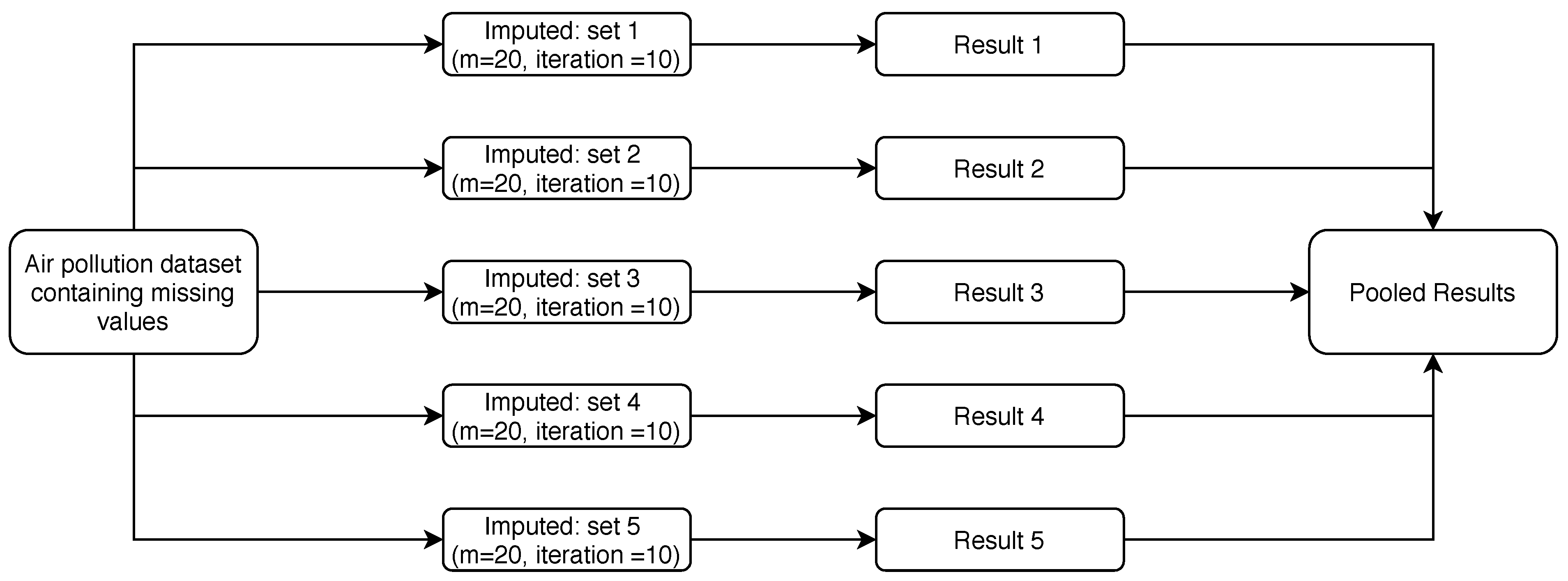
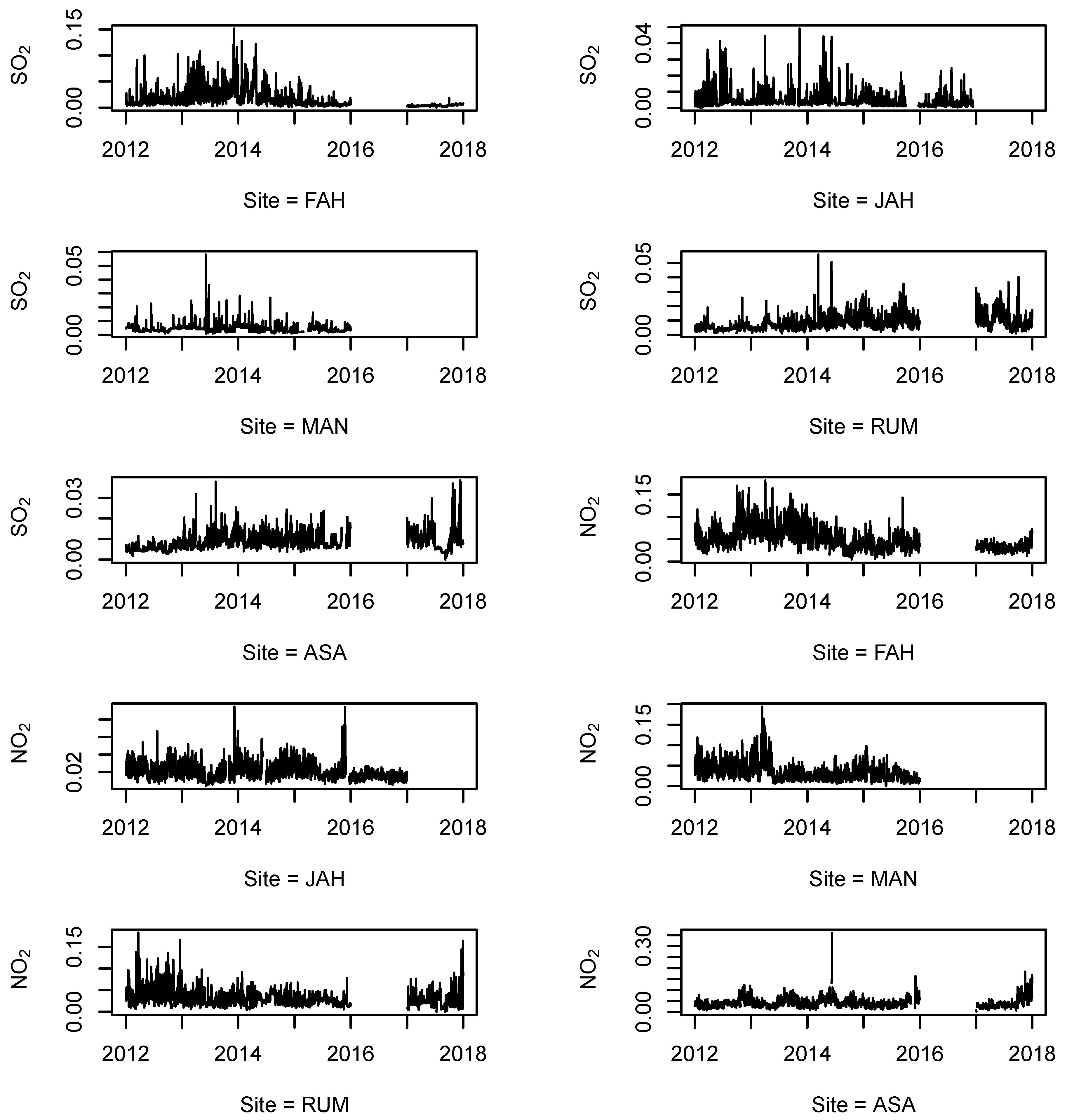
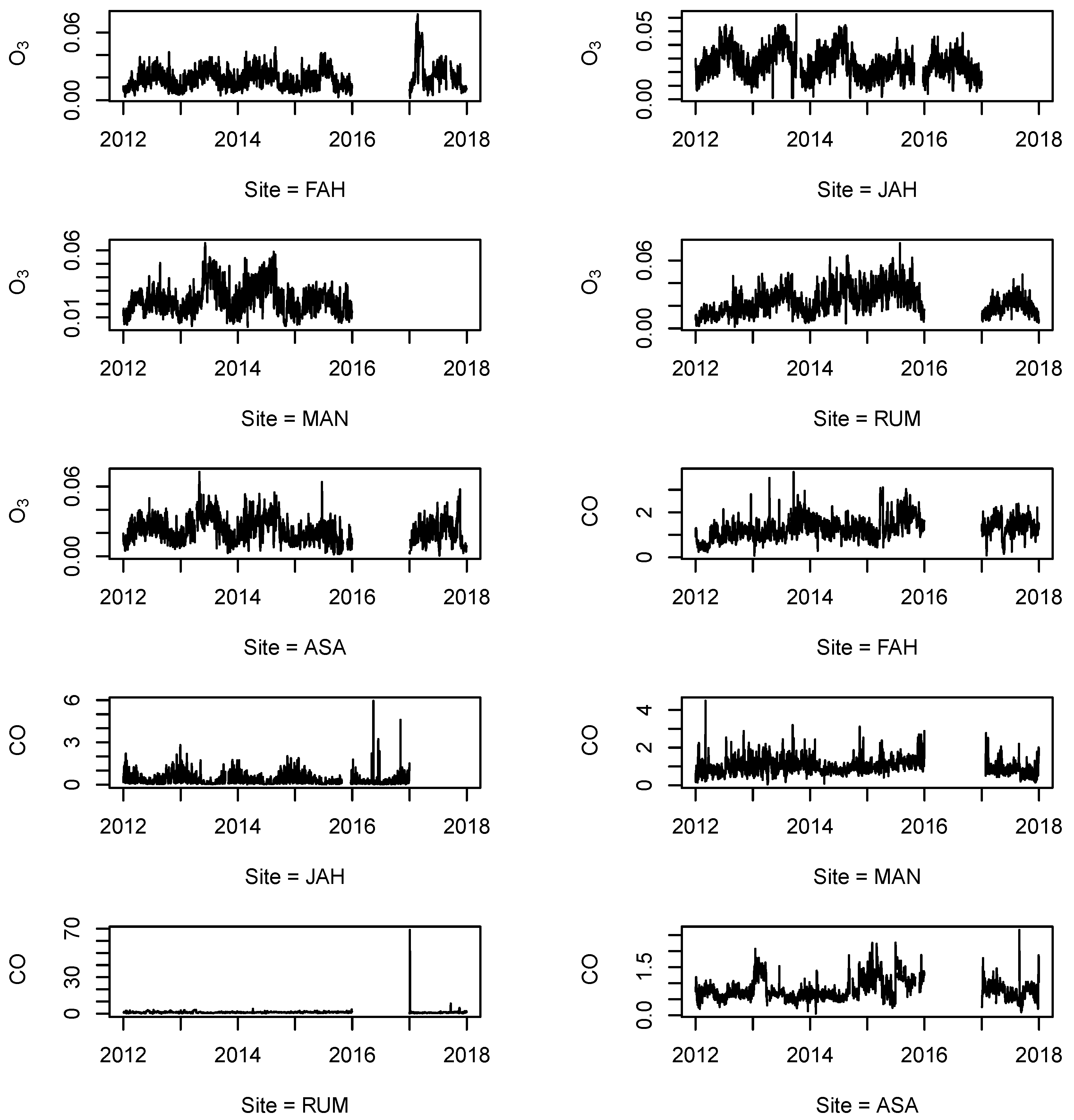
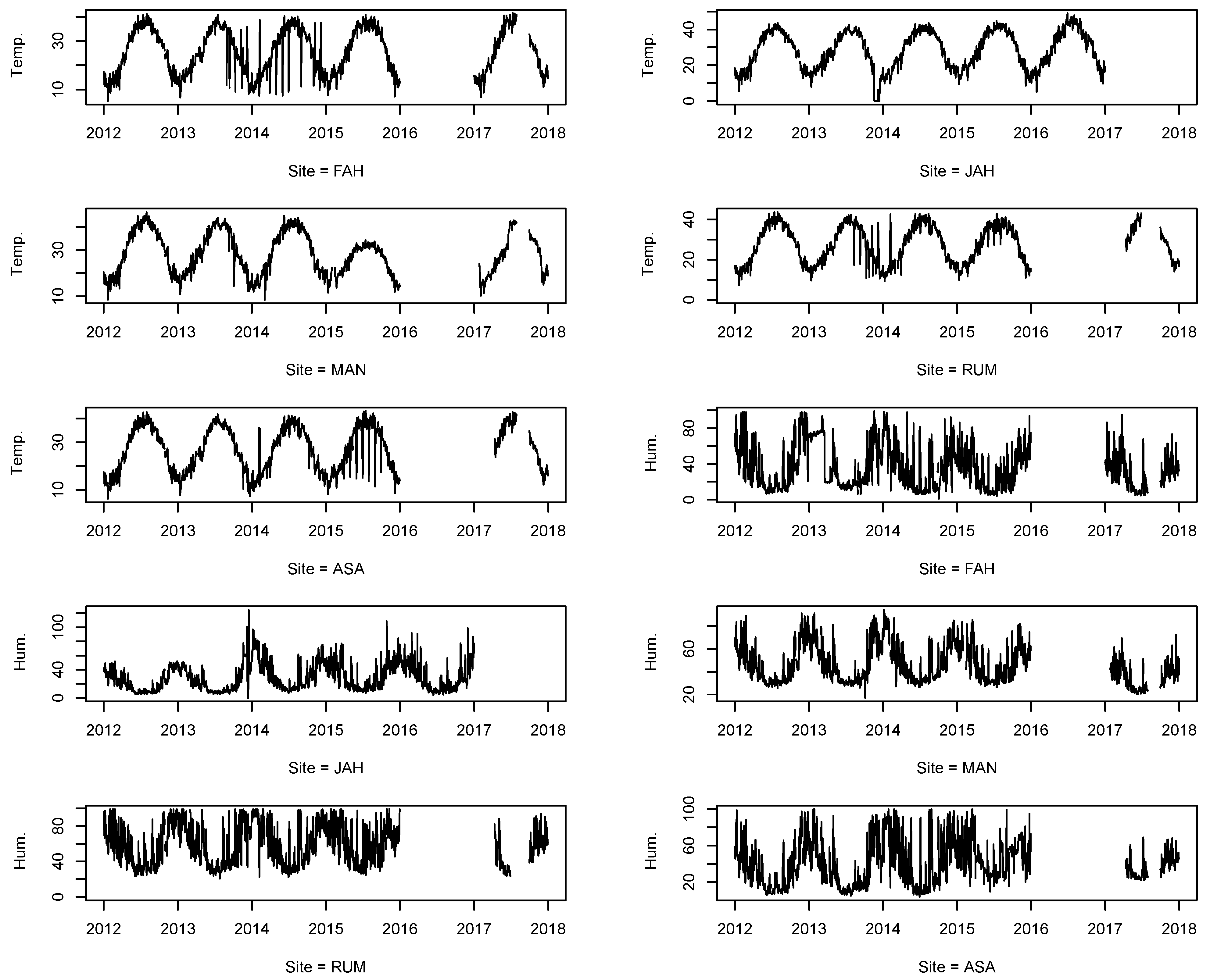
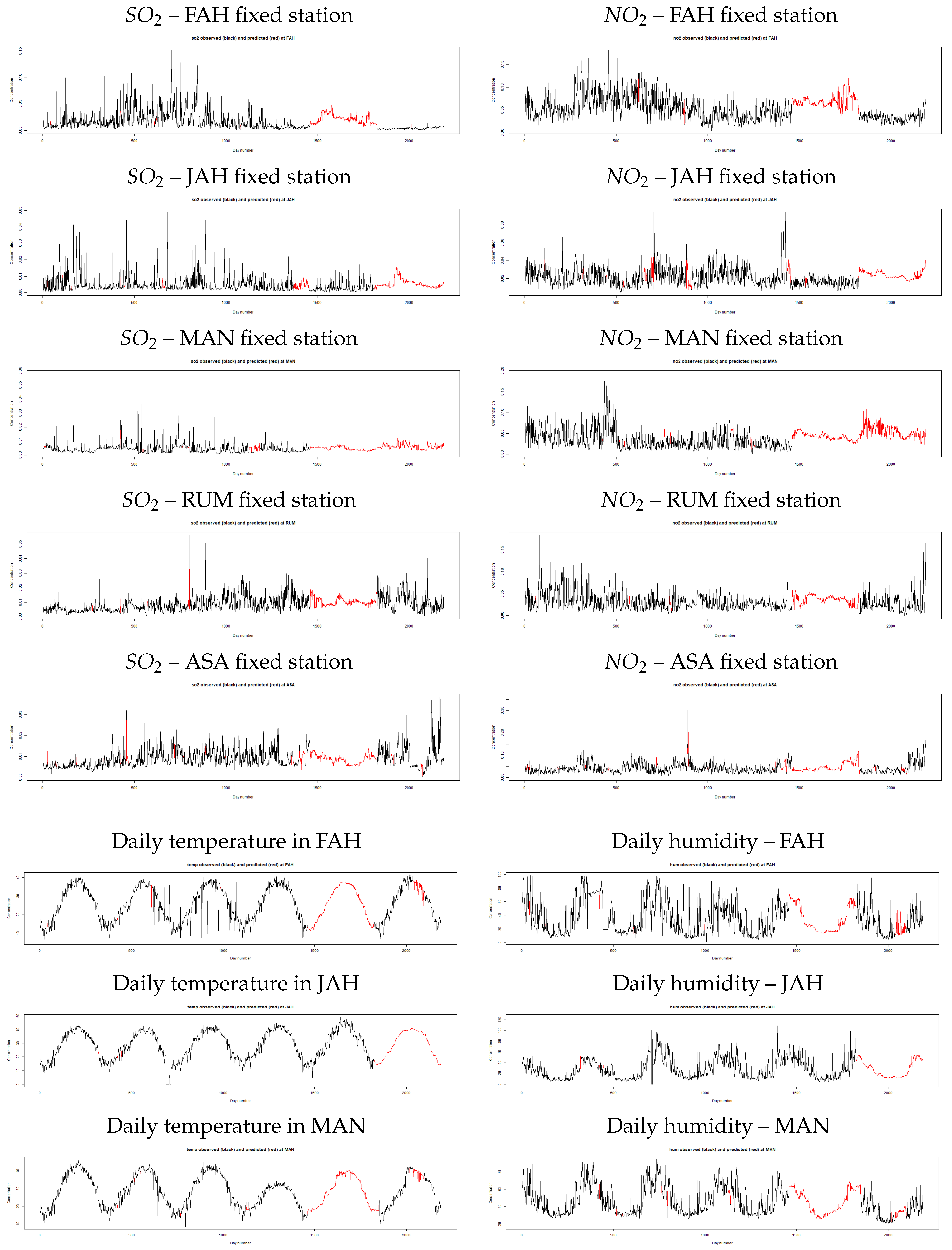
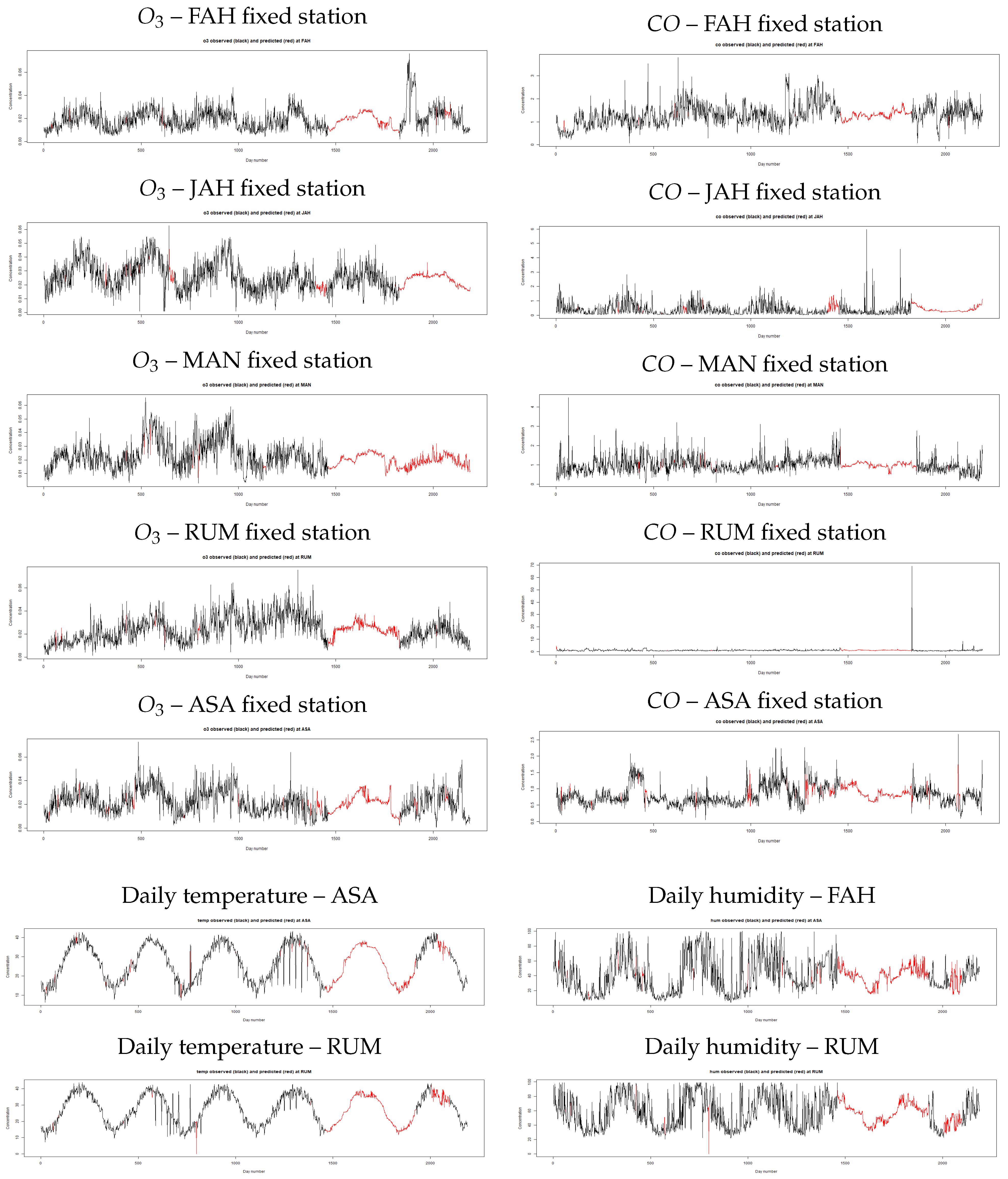
| Categories | AQI Sub-Index | O (ppm) 8-h | PM (µg/m) 24-h | CO (ppm) 24-h | SO (ppm) 24-h | NO (ppm) 24-h |
|---|---|---|---|---|---|---|
| – | – | – | – | – | – | |
| Good | 0–50 | 0.0–0.03 | 0.0–90 | 0.0–4.0 | 0.0–0.03 | 0.0–0.03 |
| Moderate | 51–100 | 0.031–0.06 | 90.1–350.0 | 4.1–8.0 | 0.031–0.06 | 0.04–0.05 |
| Unhealthy (1) | 101–150 | 0.061–0.092 | 350.1–431.1 | 8.1–11.7 | 0.061–0.182 | 0.06–0.30 |
| Unhealthy (2) | 151–200 | 0.093–0.124 | 431.4–512.5 | 11.8–15.4 | 0.183–0.304 | 0.31–0.55 |
| Very Unhealthy | 201–300 | 0.125–0.374 | 512.6–675.0 | 15.5–30.4 | 0.305–0.604 | 0.56–1.04 |
| Hazardous | 301–500 | 0.375–0.504 | 675.1–1000 | 30.5–50.4 | 0.605–1.004 | 1.05–2.04 |
| Air Pollutant | ASA | FAH | JAH | MAN | RUM | All (N = 9006) |
|---|---|---|---|---|---|---|
| min | 0.017 | 0.004 | 0.005 | 0.008 | 0.019 | 0.004 |
| 25th | 0.099 | 0.076 | 0.073 | 0.099 | 0.121 | 0.088 |
| median | 0.154 | 0.109 | 0.107 | 0.142 | 0.211 | 0.140 |
| 75th | 0.262 | 0.163 | 0.180 | 0.218 | 0.273 | 0.232 |
| max | 3.248 | 5.500 | 1.714 | 7.216 | 2.538 | 7.216 |
| mean (sd) | 0.26 ± 0.32 | 0.17 ± 0.28 | 0.17 ± 0.20 | 0.32 ± 2.38 | 0.25 ± 0.23 | 0.23 ± 1.07 |
| %Missing | %53.16 | %50.43 | %53.12 | %53.62 | %50.48 | %52.16 |
| min | 0.050 | 0.078 | 0.015 | 0.048 | 0.015 | 0.015 |
| 25th | 0.597 | 0.981 | 0.107 | 0.719 | 0.743 | 0.562 |
| median | 0.720 | 1.265 | 0.235 | 0.922 | 0.971 | 0.860 |
| 75th | 0.945 | 1.567 | 0.471 | 1.172 | 1.241 | 1.198 |
| max | 2.661 | 3.789 | 5.956 | 4.483 | 68.980 | 68.980 |
| mean (sd) | 0.80 ± 0.32 | 1.30 ± 0.47 | 0.36 ± 0.41 | 0.98 ± 0.41 | 1.08 ± 1.68 | 0.91 ± 0.90 |
| %Missing | %21.57 | %17.30 | %20.57 | %19.57 | %17.84 | %19.37 |
| min | 0.001 | 0.005 | 0.004 | 0.001 | 0.000 | 0.000 |
| 25th | 0.028 | 0.032 | 0.014 | 0.018 | 0.018 | 0.020 |
| median | 0.038 | 0.045 | 0.019 | 0.029 | 0.026 | 0.030 |
| 75th | 0.052 | 0.066 | 0.026 | 0.046 | 0.039 | 0.046 |
| max | 0.361 | 0.182 | 0.095 | 0.194 | 0.183 | 0.361 |
| mean (sd) | 0.04 ± 0.02 | 0.05 ± 0.03 | 0.02 ± 0.01 | 0.03 ± 0.02 | 0.03 ± 0.02 | 0.04 ± 0.02 |
| %Missing | %20.89 | %17.48 | %20.89 | %34.87 | %17.61 | %22.35 |
| min | 0.001 | 0.002 | 0.001 | 0.003 | 0.001 | 0.001 |
| 25th | 0.014 | 0.012 | 0.019 | 0.017 | 0.015 | 0.015 |
| median | 0.021 | 0.018 | 0.025 | 0.022 | 0.023 | 0.022 |
| 75th | 0.029 | 0.024 | 0.033 | 0.029 | 0.031 | 0.029 |
| max | 0.073 | 0.076 | 0.062 | 0.065 | 0.075 | 0.076 |
| mean (sd) | 0.02 ± 0.01 | 0.02 ± 0.01 | 0.03 ± 0.01 | 0.02 ± 0.01 | 0.02 ± 0.01 | 0.02 ± 0.01 |
| %Missing | %20.35 | %18.48 | %20.98 | %34.55 | %17.66 | %22.40 |
| min | 0.000 | 0.000 | 0.000 | 0.001 | 0.001 | 0.000 |
| 25th | 0.006 | 0.005 | 0.002 | 0.003 | 0.005 | 0.004 |
| median | 0.008 | 0.009 | 0.003 | 0.004 | 0.007 | 0.006 |
| 75th | 0.011 | 0.019 | 0.005 | 0.005 | 0.011 | 0.010 |
| max | 0.038 | 0.152 | 0.049 | 0.058 | 0.056 | 0.152 |
| mean (sd) | 0.01 ± 0.00 | 0.02 ± 0.02 | 0.00 ± 0.00 | 0.00 ± 0.00 | 0.01 ± 0.01 | 0.01 ± 0.01 |
| %Missing | %20.53 | %17.39 | %22.80 | %36.19 | %17.75 | %22.93 |
| Temp. | Hum. | Wind Speed | ||||||
|---|---|---|---|---|---|---|---|---|
| *** | ||||||||
| 0.40 *** | *** | |||||||
| 0.35 *** | *** | 0.22 *** | ||||||
| *** | 0.05 ** | * | ||||||
| Temp. | *** | 0.45 *** | *** | *** | 0.05 ** | |||
| Hum | *** | *** | 0.29 *** | *** | ||||
| Wind Speed | *** | 0.30 *** | 0.13 *** | *** | 0.10 *** | 0.24 *** | *** | |
| Wind Direction | *** | 0.13 *** | *** | *** | 0.06 *** | 0.14 *** | *** | 0.31 *** |
| ASA | FAH | JAH | MAN | RUM | p-Value | |
|---|---|---|---|---|---|---|
| N = 2192 | N = 2192 | N = 2192 | N = 2192 | N = 2192 | ||
| 454 (20.7%) | 379 (17.3%) | 454 (20.7%) | 761 (34.7%) | 382 (17.4%) | <0.001 | |
| 442 (20.2%) | 401 (18.3%) | 456 (20.8%) | 754 (34.4%) | 383 (17.5%) | <0.001 | |
| 446 (20.3%) | 377 (17.2%) | 496 (22.6%) | 790 (36.0%) | 385 (17.6%) | <0.001 | |
| 469 (21.4%) | 375 (17.1%) | 447 (20.4%) | 425 (19.4%) | 387 (17.7%) | 0.001 | |
| 1163 (53.1%) | 1103 (50.3%) | 1162 (53.0%) | 1173 (53.5%) | 1104 (50.4%) | 0.069 |
| Method | 5% Missingness Rate | |||||
|---|---|---|---|---|---|---|
| RMSE | MAE | |||||
| MCAR | MAR | MNAR | MCAR | MAR | MNAR | |
| EM | 1.430 | 1.405 | 1.536 | 1.145 | 1.120 | 1.238 |
| PMM | 1.408 | 1.430 | 1.529 | 1.129 | 1.140 | 1.225 |
| RF | 1.413 | 1.412 | 1.547 | 1.128 | 1.126 | 1.242 |
| missForest | 1.031 | 1.035 | 1.270 | 0.821 | 0.823 | 1.036 |
| BPCA | 2.110 | 1.199 | 1.568 | 1.686 | 0.953 | 1.251 |
| kNN | 1.064 | 1.065 | 1.288 | 0.850 | 0.846 | 1.047 |
| Method | 10% missingness rate | |||||
| RMSE | MAE | |||||
| MCAR | MAR | MNAR | MCAR | MAR | MNAR | |
| EM | 1.408 | 1.431 | 1.517 | 1.125 | 1.140 | 1.218 |
| PMM | 1.414 | 1.415 | 1.527 | 1.125 | 1.131 | 1.229 |
| RF | 1.414 | 1.416 | 1.529 | 1.129 | 1.133 | 1.231 |
| missForest | 1.035 | 1.028 | 1.260 | 0.829 | 0.820 | 1.025 |
| BPCA | 1.816 | 1.792 | 1.813 | 1.456 | 1.431 | 1.449 |
| kNN | 1.063 | 1.064 | 1.282 | 0.853 | 0.846 | 1.041 |
| Method | 20% missingness rate | |||||
| RMSE | MAE | |||||
| MCAR | MAR | MNAR | MCAR | MAR | MNAR | |
| EM | 1.415 | 1.410 | 1.523 | 1.129 | 1.124 | 1.225 |
| PMM | 1.418 | 1.417 | 1.528 | 1.129 | 1.131 | 1.226 |
| RF | 1.413 | 1.408 | 1.532 | 1.128 | 1.124 | 1.228 |
| missForest | 1.029 | 1.038 | 1.253 | 0.819 | 0.827 | 1.019 |
| BPCA | 1.653 | 1.548 | 1.856 | 1.319 | 1.233 | 1.478 |
| kNN | 1.062 | 1.065 | 1.270 | 0.847 | 0.850 | 1.032 |
| Method | 30% missingness rate | |||||
| RMSE | MAE | |||||
| MCAR | MAR | MNAR | MCAR | MAR | MNAR | |
| EM | 1.405 | 1.410 | 1.531 | 1.124 | 1.127 | 1.232 |
| PMM | 1.418 | 1.419 | 1.527 | 1.131 | 1.132 | 1.229 |
| RF | 1.419 | 1.419 | 1.521 | 1.136 | 1.134 | 1.224 |
| missForest | 1.034 | 1.033 | 1.255 | 0.825 | 0.823 | 1.023 |
| BPCA | 1.891 | 1.622 | 2.060 | 1.506 | 1.293 | 1.645 |
| kNN | 1.065 | 1.064 | 1.276 | 0.850 | 0.848 | 1.036 |
| Method | 40% missingness rate | |||||
| RMSE | MAE | |||||
| MCAR | MAR | MNAR | MCAR | MAR | MNAR | |
| EM | 1.401 | 1.411 | 1.518 | 1.119 | 1.127 | 1.222 |
| PMM | 1.411 | 1.399 | 1.520 | 1.126 | 1.116 | 1.222 |
| RF | 1.412 | 1.419 | 1.534 | 1.124 | 1.133 | 1.234 |
| missForest | 1.032 | 1.035 | 1.259 | 0.823 | 0.827 | 1.027 |
| BPCA | 1.564 | 1.264 | 1.789 | 1.250 | 1.007 | 1.428 |
| kNN | 1.062 | 1.067 | 1.279 | 0.847 | 0.852 | 1.042 |
Publisher’s Note: MDPI stays neutral with regard to jurisdictional claims in published maps and institutional affiliations. |
© 2021 by the authors. Licensee MDPI, Basel, Switzerland. This article is an open access article distributed under the terms and conditions of the Creative Commons Attribution (CC BY) license (http://creativecommons.org/licenses/by/4.0/).
Share and Cite
Alsaber, A.R.; Pan, J.; Al-Hurban , A. Handling Complex Missing Data Using Random Forest Approach for an Air Quality Monitoring Dataset: A Case Study of Kuwait Environmental Data (2012 to 2018). Int. J. Environ. Res. Public Health 2021, 18, 1333. https://doi.org/10.3390/ijerph18031333
Alsaber AR, Pan J, Al-Hurban A. Handling Complex Missing Data Using Random Forest Approach for an Air Quality Monitoring Dataset: A Case Study of Kuwait Environmental Data (2012 to 2018). International Journal of Environmental Research and Public Health. 2021; 18(3):1333. https://doi.org/10.3390/ijerph18031333
Chicago/Turabian StyleAlsaber, Ahmad R., Jiazhu Pan, and Adeeba Al-Hurban . 2021. "Handling Complex Missing Data Using Random Forest Approach for an Air Quality Monitoring Dataset: A Case Study of Kuwait Environmental Data (2012 to 2018)" International Journal of Environmental Research and Public Health 18, no. 3: 1333. https://doi.org/10.3390/ijerph18031333
APA StyleAlsaber, A. R., Pan, J., & Al-Hurban , A. (2021). Handling Complex Missing Data Using Random Forest Approach for an Air Quality Monitoring Dataset: A Case Study of Kuwait Environmental Data (2012 to 2018). International Journal of Environmental Research and Public Health, 18(3), 1333. https://doi.org/10.3390/ijerph18031333





